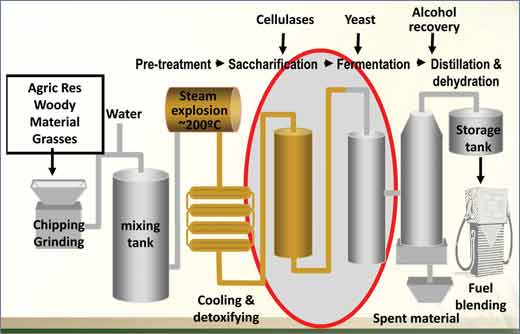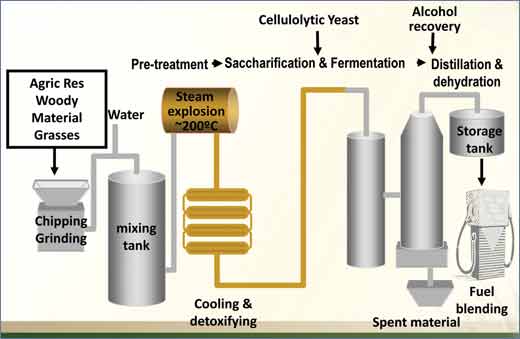Getting excited about biofuels in South Africa
-----------------
BRUSSELS, Dez. 6, 2010 (RISI) - An important technical discovery from researchers connected with Stellenbosch University in South Africa has helped eliminate a critical step in the production of ethanol from ligno-cellulose.
Stellenbosch Biomass Technologies was formed in 2009 by Prof. Emile van Zyl, Prof. Johann Görgens and senior researchers from Stellenbosch University with expertise in bioethanol and ligno-cellulose technologies. Casper Nice, former technical director of Mondi South Africa is the executive director of the company.
Generally, a two-step process - saccharification and fermentation - is needed to produce ethanol. Nice explains that in the conventional two-stage process, the first stage saccharification is done in a separate vessel with enzymes to release the sugars from the cellulose; in the second stage, the sugars are then fermented with the addition of a yeast. With genetic modification, Casper says, "Emile and his team developed a system where the yeast produces the enzyme that releases sugar and then ferments the sugar all in one process."
The technology, called consolidated bioprocessing (CBP), combines enzyme production, enzyme hydrolysis and hexose/pentose fermentation through a single organism, a cellulolytic yeast.
Prior to the discovery by van Zyl and his team, the saccharification stage was a roadblock due to the high cost of enzymes. Stellenbosch University contributed towards solving the roadblock and consolidated the process through close collaboration with US-based Mascoma Corp. Nice that the process has more than 80 patents pending.
With an existing pilot plant in the US, Mascoma has ample experience with lignocellulosic technology. It also has a design for a commercial-scale unit. Stellenbosch Biomass Technologies (SBMT) now has the license to adapt and commercialize the technology in South Africa northward through central Africa. Stellenbosch University is the strategic research partner of SBMT. To distill efficiently, the ethanol yield must be above 45g/L concentration after fermentation. Nice explains that it was difficult to achieve more than 40g/L with the two-stage process. However, Nice says, "We now can now reach up to 60g/L, a very feasible level and it uses less enzyme."
Nice adds that SBMT considers paper sludge to be a "low hanging fruit." This is important in South Africa where there is a strict government policy against converting potential food crops to ethanol production. Besides wood waste, bagasse from sugar refining is also an important source of raw material.
There is still some question of which markets any ethanol produced will serve in South Africa. Nice says that their main objective is to produce transportation fuel. But, Nice explains, South African regulations currently restrict ethanol content to 4% in petrol. "We need to change the regulations to at least 10-15%. This is what we hope for."
A significant niche market for ethanol gel as a safe alternative to kerosene for domestic cooking is also in development.
|
Figure 1 - Ethanol production from ligno-cellulose (fibrous plant biomass)
|
 |
For a pulp mill, Nice says that a 2,000-tonne/day pulp mill produces about 80 tonnes of sludge that is probably going to landfill. This can be converted to ethanol.
To produce ethanol straight from wood, 150,000 tonnes/yr of chips could produce 40 million liters of ethanol along with about 10 MW of electricity. Helping the cause is a South African program, Working for Water, which is aimed at cutting invasive flora species that consume water, a relatively scarce commodity in the country. This could equate to about 2.5 million tonnes/yr of wood. The cellulose levels among the species are about the same (45-55%). Commercial installations will require 150,000 to one million tonnes/yr of feedstock.
The technology can also be adapted to local feedstocks such as bagasse , straw or bran.
The economics for a standalone plant are not quite there yet. Nice estimates the capital investment to be about 8 to 10 rand ($1.14-$1.43) per liter of ethanol. Therefore, a facility producing 10 million L/yr would cost about 100 million rand ($14.3 million).
The cost to produce is about 4-5 rand per liter, which equates to about $80 per barrel crude oil. However, current value is about $72 per barrel, "So we are not quite there yet."
|
Figure 2 - Ethanol production from ligno-cellulose (mascoma process)
|
 |
However, Nice is confident that further development will bring production costs down. As well, government incentives to reduce fossil fuel use may also be in play. Finally, companies that want to reduce their carbon footprint and present a "green" image may be willing to pay a premium.
"To put up a standalone wood-to-ethanol plant is not feasible today," Nice says. However, he adds that sludge to ethanol is feasible (eight to 10 year payback) as is a second-generation sugar to ethanol production plant. Currently, it looks like the sludge option is the best bet to be developed first.
Nice speaks of a two-pronged approach. The first is to use paper sludge where only a small reactor is needed.
The second step would be to build a two-ton/day demonstration plant that could use wood or bagasse as the feedstock. Nice says that the sugar and pulp and paper industries have shown interest as have the farmers' cooperatives.
Nice admits that the concept could be considered as competition for the pulp and paper industry because wood would be converted directly to energy. However, he adds that much wood is still available in Southern Africa that is not being used now so that it would not affect the pulp and paper mills. Future mills could be designed for a better utilization of the whole tree and incorporate both pulp and ethanol production on the same site, focusing on the use on non-pulp residues for bio-ethanol production.
Nice is hoping that further development will lead to a commercial plant in operation by 2014. He says 40 million L/yr of ethanol would be the minimum production needed to be feasible.
The technology is still in its "infant shoes", says Nice, but he adds, "It is getting to the stage where it is exciting."
---------------

